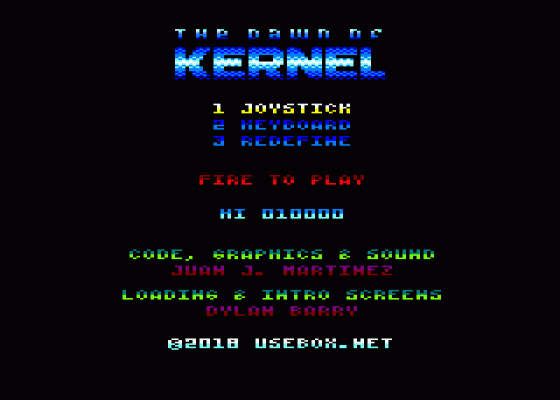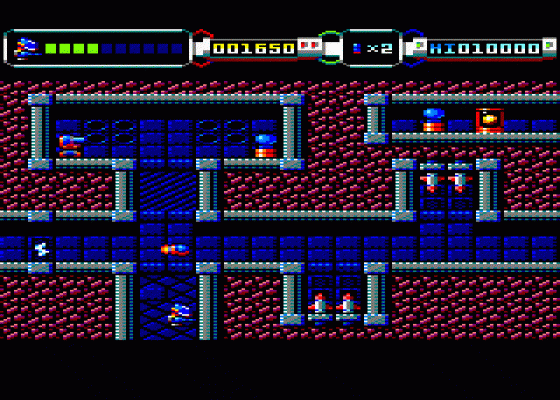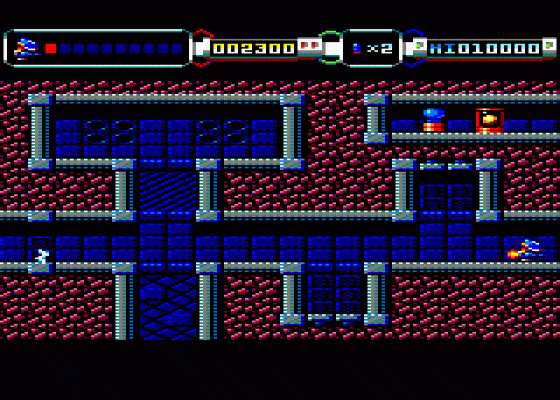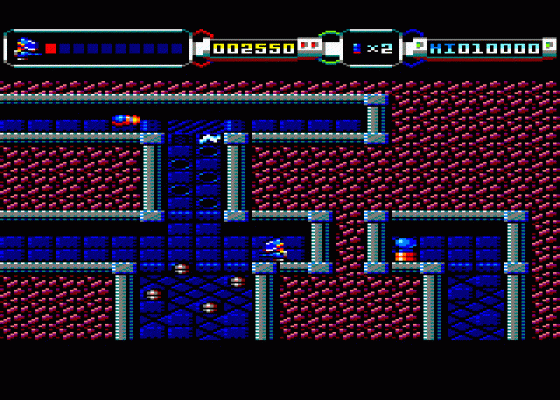
Eight Bit Magazine
 1st December 2019
1st December 2019
Categories: Review: Software
Author: George Bachaelor
Publisher: Usebox.net
Machine: Amstrad CPC464/664
Published in 8 Bit Annual 2019
The Dawn Of Kernel
I must say I was rather surprised and honoured to be asked to write this review on The Dawn Of Kernel by the 8-Bit Annual guys and, in all honesty, quite apprehensive! Writing about games is not exactly my forte, but since I've spent a lifetime playing them and also have a rather adequate grasp of the English language, I thought I would give it a go. [That's the gaming spirit we want to see - Ed]
The Dawn Of Kernel, the latest game to be developed by Juan J Martinez, the creator of Amstrad CPC games such as Magica and Golden Tail, two very different yet well received games from 2016. It was easy to be quite eager to see what Juan would come up with in his latest Amstrad CPC game offering. Although The Dawn of Kernel was available to download for free from usebox.net ages ago, I thought, for added authenticity I would wait and order my preferred medium - The cassette. A classic, almost defunct form of game software quickly taken over by floppy disks and eventually, cartridges, cds and now digital downloads, but it is a form of old school nostalgia that adds a certain 'pizzazz' to the gaming experience almost a time portal to my youth! I waited rather patiently for several months for the boxed version to be released and finally arrive via snail mail and thankfully I wasn't disappointed.
Upon pressing play you encounter a very colourful loading screen which captures the colour scheme of the box artwork quite well. A variety of vibrant pinks, deep purples and bright blues contrast nicely against one another. We are now introduced to the game via mini cut scene style movie intro its only one screen stating something along the lines of "Mining planet k3E-NL of the Leonis system is sending a distress signal. They are having to evacuate the mining base due to a computer virus that has spread quickly through their entire network and is inevitably causing catastrophic problems for the life support of all the personnel". We are then left with the message "Kernel lives". The games menu screen lets you choose either joystick or keyboard. I actually used an Amstrad GX4000 gamepad whilst reviewing this game and found it worked really well [I hate those NES-style gamepads. The buttons are too small and the plastic too hard on your thumb. But that's just me - Ed]. The spaceship on the screen can be moved left and right and pressing up causes the ship to engage its thrust, mastering this is a must in order to progress through the levels!
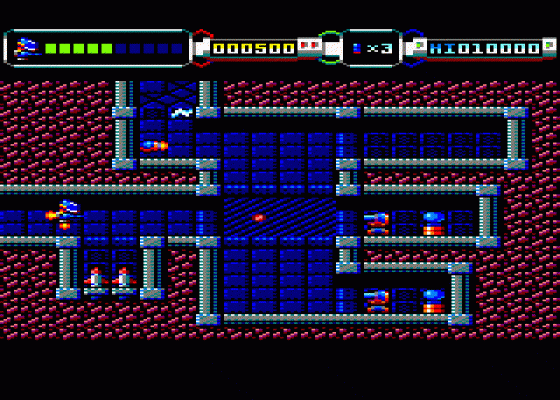
What struck me instantly was the feeling that I had played the game before, many years ago, hmmm, I observe that thankfully the games controls are superb! It wasn't too long before I was dodging enemy fire and taking out floating mines with ease. It really helps that the hit detection is absolutely spot on, putting a lot of other games to shame. Then it hits me, I realise this is a game very much in the vein of Cybernoid 1 and 2 from Rafale Cecco, circa 1988 [I concur, I wonder what Raf Cecco would think about this game, hmmm? - Ed].
Back to The Dawn Of Kernel - you can get within a pixel of the enemy with no collision problems whatsoever, but you have to be very careful, especially with the sentry rockets. The ship comes with two defensive guns, the primary weapon is a fairly slow shooting gun type which takes out most enemies with a couple of hits, it does have unlimited ammo though [See, it ain't so bad! - Ed]. The secondary weapon on the spaceship is a missile gun with a greater power, taking out most enemies with one hit but has limited shells.
The game is a flip screen shoot-'em-up or 'shump' for those who like abbreviations. To the gameplay. You need to fly around all the levels trying to take out the power stations, taking out the power stations lowers the energy field barriers and that's what makes more of the games levels accessible. As well as the power stations you also encounter a variety of enemies trying to halt your progress. These include mines that explode at the slightest touch, sentry rockets that will shoot you as soon as you are within reach, diggers that aren't affected by your ships weapons - they can only be avoided. Whilst destroying the power stations, random pickups will become available to collect including missiles which add 3 rounds to the secondary weapon of your ship. Also available to collect are shield cells which increases your energy by three units, boy do these come in handy.

Nova bombs are an excellent weapon to collect because they work like a smart bomb, destroying all the enemies on screen. Getting hit by enemy fire or coming into contact with them will cause your energy level to drop, this is shown by the segmented bar at the top of the screen, losing all your energy will cause your ship to be destroyed, ending the game. You only get one life, so progress can be on the high side of difficulty. Finishing a level doesn't replenish your health so taking your time and knowing the enemy placements is essential to getting further into the game. The game is subdivided into 6 levels with the ability to move from one level to another. There are three hidden teleporters to access three hidden areas: one at level 4 and two at level five.
What I Like
In terms of the games visuals, there's a nice amount of detail to each level. The sprites are well animated and stand out well against the background graphics. The use of the CPC's colour palette is excellent as per usual with games developed by Juan J. Martinez. As for the music and sound effects. The games music is quite catchy, you'll be humming it in the back of your head for quite some time and the in game sound effects do the sounds of firing and explosions ample justice. There are different tunes playing throughout which begs the question why couldn't more CPC games of the 1980's be like this?
The gameplay and playability have that grab factor that keeps you coming back for more. I was more than impressed by the games mechanics and the use of the Cybernoid playing style. The combat has been given much attention to detail, even though from a playing perspective it can be quite frustrating. At the heart of the game is the combat experience, there is just the right amount of combat strategy and shoot-'em-up addiction to keep you wanting more.
What I Didn't Like
Only having one life to get through the entire game is tough gaming. I got the feeling the energy shield can deplete way too quickly when you are not aware of the game mechanics. Getting the power up you want doesn't always seem possible either. Certainly high on difficulty, so repeating sections often before you advance further may frustrate you and drive you crazy a lot. Some sections appear impossible, even though I know they aren't and some may feel this might mar your enjoyment of what is a great game. I was really hanging out for a heat seeking missile like one used in Cybernoid 2, a weapon like that in this game would have been a brilliant addiction as well as addition and in my mind would have sent the game's appeal soaring. [Always getting 'whacked' out on the good stuff aren't you? - Ed]
Verdict
So after many extensive playthroughs, I can say that Juan J Martinez has made a stand-out Amstrad game. Excellent graphics, fantastic tunes, a great plot that matches the gameplay and sublime controls make this challenging game a must play. Over time you will be able to remember where the enemy placements are and you'll be able to fly through the first few levels with ease. Later levels will take a lot more skill to get though, so it definitely has that 'just one more go' thing going for it. Just a shame you only have one life to work with. Otherwise, I can definitely recommend downloading this game for free or for you to be the proud owner of the physical copy. The Dawn Of Kernel simply demands to be played, so get blasting [Say no more, I have been blasting away for the past 8 months and I just made it to level two - Ed].


